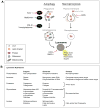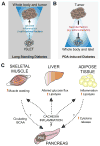Pancreatic Cancer Metabolism: Breaking It Down to Build It Back Up
- PMID: 26534901
- PMCID: PMC4687899
- DOI: 10.1158/2159-8290.CD-15-0671
Pancreatic Cancer Metabolism: Breaking It Down to Build It Back Up
Abstract
How do cancer cells escape tightly controlled regulatory circuits that link their proliferation to extracellular nutrient cues? An emerging theme in cancer biology is the hijacking of normal stress response mechanisms to enable growth even when nutrients are limiting. Pancreatic ductal adenocarcinoma (PDA) is the quintessential aggressive malignancy that thrives in nutrient-poor, hypoxic environments. PDAs overcome these limitations through appropriation of unorthodox strategies for fuel source acquisition and utilization. In addition, the interplay between evolving PDA and whole-body metabolism contributes to disease pathogenesis. Deciphering how these pathways function and integrate with one another can reveal novel angles of therapeutic attack.
Significance: Alterations in tumor cell and systemic metabolism are central to the biology of pancreatic cancer. Further investigation of these processes will provide important insights into how these tumors develop and grow, and suggest new approaches for its detection, prevention, and treatment.
©2015 American Association for Cancer Research.
Conflict of interest statement
Figures




References
-
- Ryan DP, Hong TS, Bardeesy N. Pancreatic adenocarcinoma. N Engl J Med. 2014;371:2140–1. - PubMed
Publication types
MeSH terms
Substances
Grants and funding
LinkOut - more resources
Full Text Sources
Other Literature Sources
Medical
Molecular Biology Databases

